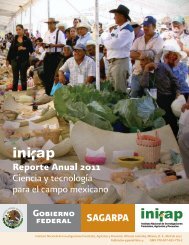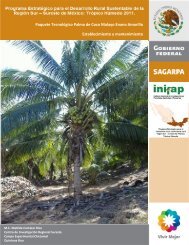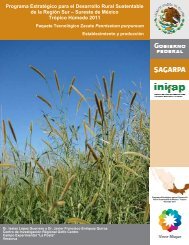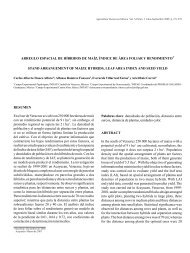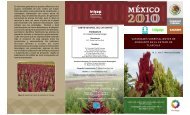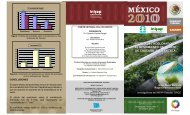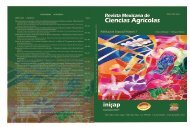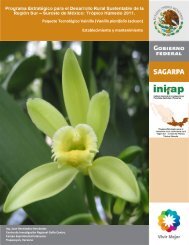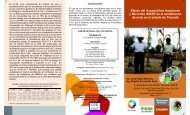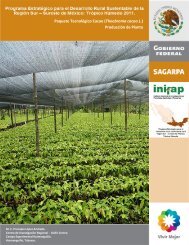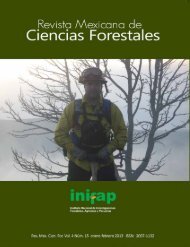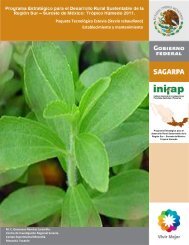Vol. 2 Núm. 8 - Instituto Nacional de Investigaciones Forestales ...
Vol. 2 Núm. 8 - Instituto Nacional de Investigaciones Forestales ...
Vol. 2 Núm. 8 - Instituto Nacional de Investigaciones Forestales ...
- No tags were found...
Create successful ePaper yourself
Turn your PDF publications into a flip-book with our unique Google optimized e-Paper software.
Rev. Mex. Cien. For. <strong>Vol</strong>. 2 Núm. 8INTRODUCCIÓNLa conversión <strong>de</strong> los bosques maduros en áreas abiertaspara diferentes usos económicos <strong>de</strong>l suelo, como agriculturao gana<strong>de</strong>ría, es un fenómeno que se ha presentado a lolargo <strong>de</strong> los últimos siglos (Herrera et al., 2001). Los bosquesestán <strong>de</strong>ntro <strong>de</strong> los ecosistemas naturales con mayorproducción primaria neta. Se calcula que producen <strong>de</strong>400 a 1,000 g m -2 año -1 <strong>de</strong> carbono, cantidad dos vecessuperior a la <strong>de</strong> los pastizales y varias veces mayor que la <strong>de</strong>los océanos (Waring y Schlesinger, 1985). Una parte <strong>de</strong> estaproducción se acumula como biomasa y humus, que constituyenla producción primaria neta. La otra parte se <strong>de</strong>stina a procesos<strong>de</strong> mantenimiento <strong>de</strong>l ecosistema, a través <strong>de</strong> la respiración(Escandón et al., 1999).Garzuglia y Saket (2003) <strong>de</strong>finen la biomasa aérea comola cantidad total <strong>de</strong> materia orgánica aérea presente en losárboles, e incluyen hojas, ramas, tronco principal y corteza.Para la estimación <strong>de</strong> biomasa, el procedimiento más comúnconsiste en el muestreo <strong>de</strong>structivo <strong>de</strong> unos cuantos árbolespara <strong>de</strong>spués mo<strong>de</strong>lar el contenido <strong>de</strong> biomasa en función<strong>de</strong> variables fáciles <strong>de</strong> medir, para ello se utilizan métodos <strong>de</strong>regresión (Díaz et al., 2007).La biomasa se ha convertido en un elemento importante enlos estudios sobre los cambios que ocurren a escala mundial,dado el posible efecto atenuador (sumi<strong>de</strong>ro <strong>de</strong> carbono) quelos bosques pue<strong>de</strong>n tener al secuestrar los exce<strong>de</strong>ntes <strong>de</strong> losgases <strong>de</strong> efecto inverna<strong>de</strong>ro, <strong>de</strong> un modo temporal (biomasa)y permanente (suelo) y a las consecuencias que se <strong>de</strong>rivan <strong>de</strong>la modificación <strong>de</strong> las condiciones climáticas sobre lasalud, estructura y biodiversidad <strong>de</strong> un sistema forestal(Vidal et al., 2004).Las ecuaciones <strong>de</strong> biomasa permiten estimar, con bastanteexactitud, el peso <strong>de</strong> las especies forestales a partir <strong>de</strong> unnúmero reducido <strong>de</strong> parámetros <strong>de</strong> los árboles en pie (Lópezy Keyes, 1987; Castellanos et al., 1996; Rojo et al., 2005). Sinembargo, la disponibilidad <strong>de</strong> mo<strong>de</strong>los para coníferascomo Abies religiosa (Kunth) Schltdl. et Cham. es reducida. EnMéxico se han <strong>de</strong>sarrollado ecuaciones para Pinus montezumaeLamb. (Garcidueñas, 1987; Manzano et al., 2007; López-Lópezet al., 2009), Pinus cembroi<strong>de</strong>s Zucc. (López y Keyes, 1987), Pinuspatula Schltdl. et Cham. (Castellanos et al., 1996), Alnus glabrataFernald, Clethra hartwegii Britt., Rapanea myricoi<strong>de</strong>s (Schltdl.)Lun<strong>de</strong>ll, Quercus peduncularis Née, Liquidambar macrophyllaOerst e Inga sp. (Acosta et al., 2002), Hevea brasiliensis Müll.Arg. (Rojo et al., 2005) y para Abies religiosa (Avendaño et al., 2009).Los mo<strong>de</strong>los para el cálculo <strong>de</strong> la biomasa <strong>de</strong> árbolesestán influenciados por los cambios en la estructura, comoconsecuencia <strong>de</strong>l manejo, presencia <strong>de</strong> plagas y enfermeda<strong>de</strong>s,condiciones climáticas, <strong>de</strong> suelo o incluso factores genéticos.INTRODUCTIONThe conversion of old forests into open areas for differenteconomic land use such as agriculture or livestock farming hasoccurred during the last centuries (Herrera et al., 2001).Forests are one of the natural ecosystems with highest netprimary production. It has been calculated that they produce from400 to 1,000 g m -2 year -1 C, which is an amount twice higherthan grasslands and several more than that of oceans (Waringand Schlesinger, 1985). One part of production accumulates asbiomass and humus, which constitute the net primary production.The other part is bound to maintenance process of theecosystem, through respiration (Escandón et al., 1999).Garzuglia and Saket (2003) <strong>de</strong>fine aerial biomass as thetotal amount of aerial organic matter in trees, including leaves,branches main stem and bark. The most regular procedurefor biomass estimation is <strong>de</strong>structive sampling of some trees fora later mo<strong>de</strong>ling of biomass content in terms of easilymeasurable variables, in which regression methods are used(Díaz et al., 2007).Biomass has become an important element in studiesabout changes that occur world-wi<strong>de</strong>, from the possiblemitigating effect (carbon sink) of forests when they performthe sequestration of the exceeding greenhouse- effect gases,in a temporary (biomass) or permanent (soil) way and to theconsequences of the changing climate conditions upon health,structure and biodiversity of a forest system (Vidal et al., 2004).Biomass equations allow a rather accurate estimationof the weight of forest species from a small number ofstanding-tree parameters (López and Keyes, 1987; Castellanoset al., 1996; Rojo et al., 2005). However, the availability ofmo<strong>de</strong>ls for softwoods such as Abies religiosa (Kunth) Schltdl.et Cham. is rather small. Some equations have been <strong>de</strong>velopedin Mexico for Pinus montezumae Lamb. (Garcidueñas, 1987; Manzanoet al., 2007; López-López et al., 2009), Pinus cembroi<strong>de</strong>s Zucc.(López y Keyes, 1987), Pinus patula Schltdl. et Cham. (Castellanoset al., 1996), Alnus glabrata Fernald, Clethra hartwegii Britt.,Rapanea myricoi<strong>de</strong>s (Schltdl.) Lun<strong>de</strong>ll, Quercus peduncularisNée, Liquidambar macrophylla Oerst e Inga sp. (Acosta et al.,2002), Hevea brasiliensis Müll. Arg. (Rojo et al., 2005), as wellas for Abies religiosa (Avendaño et al., 2009).Mo<strong>de</strong>ls for tree biomass are influenced by changes instructure, as a consequence of management, plagues anddiseases, climate, soil and even some genetic factors.Forest <strong>de</strong>cline is <strong>de</strong>fined as a multifactor sickness caused bybiotic and abiotic agents that generates a <strong>de</strong>crease of vigorand survival of trees (Granados et al., 2001 and Vázquez etal., 2004). Ciesla (1989) and Granados et al. (2001) point outthat there are symptoms related to this phenomenon, among10



